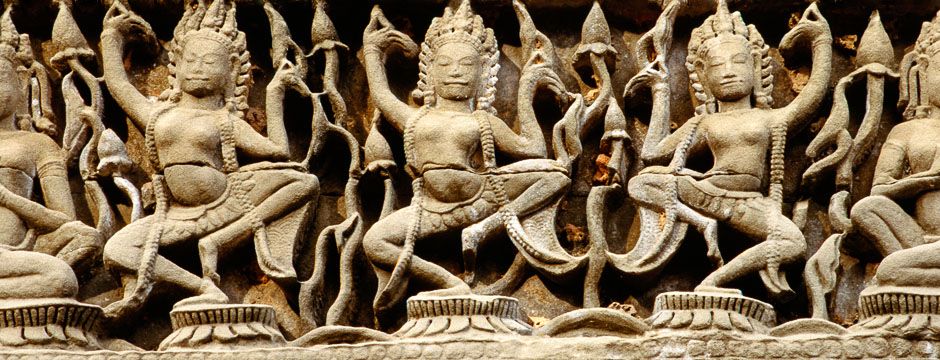Part 1: Arrival
I first visited the UNESCO world heritage site of Angkor Wat in 1999 after a friend who lives in Bangkok insisted I should go there, I also remember his advice to ‘keep to the paths’. Getting to Siem Reap (the gateway town to Angkor Wat) in those days was a very tough and long journey, especially travelling with Mamiya RZ medium format equipment that I was shooting on in those days. I needed lots of rolls of 120 Fuji Velvia film, polaroid for my polaroid back, various lenses and of course my Manfrotto tripod.
As a professional travel photographer I have been fortunate to visit amazing locations around the planet, however, the magical temples of Angkor Wat stopped me in my tracks. I immediately fell in love with a country, its people, a place and I started to formulate a photographic project which would see me returning on numerous occasions.
I was taken by the beauty of the stonework and the detail of the carved stone, just about every square metre of the temples had been carved with intricate patterns, smiling contemplative faces and Apsaras (supernatural female beings in Hindu and Buddhist mythology).
In 1999 Cambodia was one of the most densely land mined countries in the world. Certain temples you could only walk where you knew others had been, as there were still uncleared land mines, hence my friends advice to “keep to the paths”. Many people were also victims of land mines, so I decided that the project that I was to work on would be a collection of large fine art photographic prints for exhibition, and I would donate a percentage of the proceeds to land mine clearance charities.
In these early days of visiting I was starting to formulate the exhibition in my head. Instead of showing the wider view I decided to concentrate on the details which had originally caught my eye. My style at this time was tight, close cropped images.
It was hard not to be captivated by the lifelike beauty of the heavenly bodied Apsara celestial dancers that are seen everywhere in all the temples.
The 120 roll film I used on these earlier visits only had 10 frames per roll so each shot had to be well considered, exposed correctly and technically perfect. My medium format photography was always tripod based as I was using 50 ISO Fuji Velvia film at the time, often with long exposures. Shooting with a camera on a tripod slows things down and makes you really concentrate on observing light and properly framing an image. Years of shooting with only medium format cameras taught me to get everything right in camera, which carried over to my later digital photography.
The light is constantly moving around the temples, often with dappled sunlight filtering through the jungle canopy, moving across the carvings, adding more depth and atmosphere to the photographs.
My photographic project was never intended as a travel guide to the temples of Angkor Wat . Instead it has been to convey my emotional response to this place of mystery, wonder and beauty, emphasising the force of nature over humankind. It is a photographic project that has evolved over time as I returned to the temples over many years.
Join me next week as we will continue the journey and explore how nature is reclaiming the temples.
Stephen Studd
Stephen Studd is an award winning professional travel & garden photographer from the UK. Stephen also runs photography holidays and workshops to Angkor Wat, Cambodia, Myanmar, Marrakech, Venice, Prague & Paris with his company Digital Photography Holidays.
Websites:
Digital Photography Holidays:
www.digitalphotographyholidays.com
www.stephenstuddphotography.com









